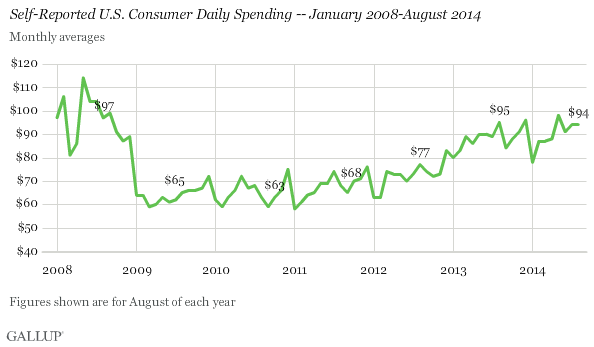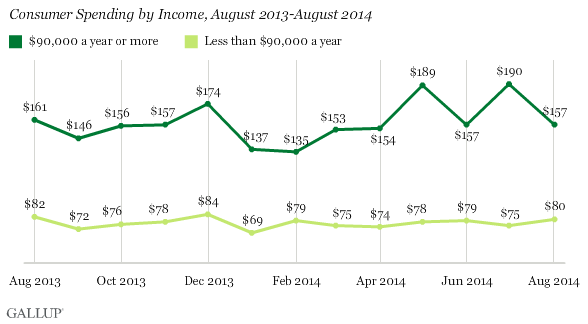WASHINGTON, D.C. -- Americans' self-reports of daily spending averaged $94 in August, matching the average for July. Spending last month was also similar to the $95 average in August 2013.

These figures are based on Gallup Daily tracking interviews with more than 15,000 Americans throughout August. The poll asks Americans to report the total amount they spent "yesterday" in stores, gas stations, restaurants, or online -- not counting home and vehicle purchases, or normal monthly bills -- and gives an indication of discretionary spending.
Throughout 2014, the monthly averages in Americans' self-reported daily spending have consistently exceeded figures in the same months for each year from 2009 through 2012 -- both during and after the recession. But spending is still below the $100 averages routinely seen in 2008 before the financial crisis occurred in the fall. In May of this year, spending nearly reached the $100 level, peaking at $98. After dropping to $91 in June, average spending recovered somewhat to $94 in July and was flat in August.
Last month's spending average ($94) is nearly identical to August 2013 spending ($95). But last August was the second-highest spending month for Americans in 2013. How this measure tracks over the next few months will indicate whether spending in 2014 has, in fact, steadied at the higher levels reached in late 2013, or whether the momentum seen earlier this year picks up again.
Spending Dips Among Higher-Earning Americans
After reaching a high for the year of $190 in July, spending among Americans with household incomes of at least $90,000 dipped to an average of $157 for August. This is consistent, however, with higher earners' overall spending in the past year, and about the same as what high-income earners spent last August ($161).

That decline in upper-income spending was offset by an increase in spending among middle- and lower-income Americans -- the bulk of U.S. consumers. Middle- and lower-income consumers' daily spending reports averaged $80 in August, compared with $75 in July.
Bottom Line
Though higher-income earners may have spent less in August, middle- and lower-income-earning Americans picked up the slack -- thus keeping overall spending flat.
August 2014 consumer spending may not have exceeded the previous August's figure, but spending this year has been steady. The larger pattern since 2012 has been one of increased consumer spending, which is crucial to the U.S. economy's recovery.
Survey Methods
Results for this Gallup poll are based on telephone interviews conducted Aug. 1-31, 2014, on the Gallup Daily tracking survey, with a random sample of 15,206 adults, aged 18 and older, living in all 50 U.S. states and the District of Columbia.
For results based on the total sample of national adults, the margin of sampling error is ±1 percentage point at the 95% confidence level. The margin of error for the spending mean is ±$4.
Interviews are conducted with respondents on landline telephones and cellular phones, with interviews conducted in Spanish for respondents who are primarily Spanish-speaking. Each sample of national adults includes a minimum quota of 50% cellphone respondents and 50% landline respondents, with additional minimum quotas by time zone within region. Landline and cellular telephone numbers are selected using random-digit-dial methods. Landline respondents are chosen at random within each household on the basis of which member had the most recent birthday.
Samples are weighted to correct for unequal selection probability, nonresponse, and double coverage of landline and cell users in the two sampling frames. They are also weighted to match the national demographics of gender, age, race, Hispanic ethnicity, education, region, population density, and phone status (cellphone only/landline only/both, and cellphone mostly). Demographic weighting targets are based on the most recent Current Population Survey figures for the aged 18 and older U.S. population. Phone status targets are based on the most recent National Health Interview Survey. Population density targets are based on the most recent U.S. census. All reported margins of sampling error include the computed design effects for weighting.
In addition to sampling error, question wording and practical difficulties in conducting surveys can introduce error or bias into the findings of public opinion polls.
For more details on Gallup's polling methodology, visit www.gallup.com.
